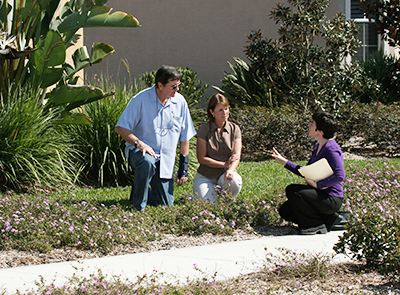Dealing with Water Restrictions

A water management district agent talks with developers about incorporating drought-tolerant plant species in home landscapes.
During a drought or water shortage, or when conditions indicate a drought may be imminent, Florida's water management districts have the authority to restrict water use in home landscapes.
Always follow water restrictions! They describe how many days a week you can water your landscape, and often which days and times of day, as well. These restrictions ensure that all of us have enough water.
There can be exceptions in the water restrictions for edible plants and newly installed landscapes. Read and understand the restrictions clearly and, when in doubt, contact your local water authority or water management district.
Florida's sandy soils mean that plants may experience drought stress after only a few days without rain or irrigation. So how do you keep your plants alive while following your water management district's watering schedule? Follow these guidelines.
Establish priorities. If you have high-maintenance and drought-sensitive plants, water them first. Grass should be a lower priority—it can be trained to be fairly drought-tolerant (especially bahiagrass and centipedegrass), and is cheaper to replace than trees and shrubs.
Consider replacing drought-sensitive plants with more drought-tolerant species. Choosing drought-tolerant plants when replacing plants or adding new plants to the landscape can help you save money and conserve water.
Mulch planting beds and areas around trees and shrubs. Mulching helps the soil retain moisture, moderate soil temperature, and keep weeds down. The mulch should be about 3 inches deep.
Turn off automatic irrigation systems during cool winter weather and rainy summer weather. Run your irrigation system only when your landscape really needs the water. Handwater when possible, or consider using drip irrigation. (The water management districts do not restrict the use of drip irrigation and other types of microirrigation, at least in non-lawn landscapes.)
Irrigate plants only when they need it (drooping leaves or a change in leaf color are good indicators). Many trees and shrubs can survive drought without irrigation, provided they are well established and were healthy prior to the drought. Water in the morning so less moisture is lost to evaporation.
Examine your irrigation system and repair leaks promptly.
Don't fertilize or, if you do, use low nitrogen and low phosphorus fertilizers. Fertilization stimulates growth and increases water needs. Avoid unnecessary applications of pesticides that require "watering in"—you can almost certainly find pesticides that work without added water.
Shade. Move container plants to shaded areas to reduce their water needs.

